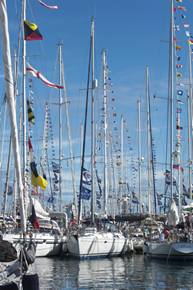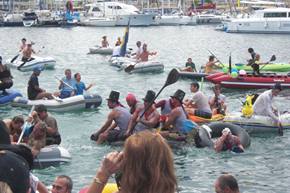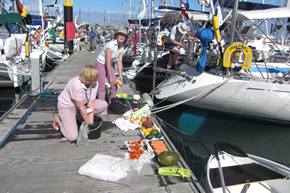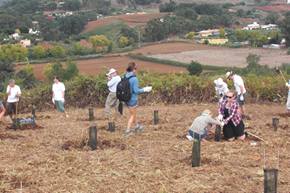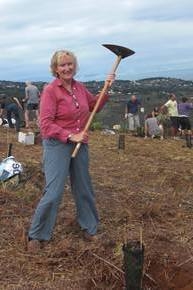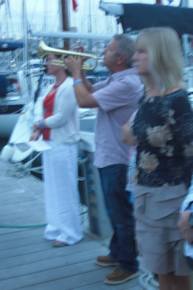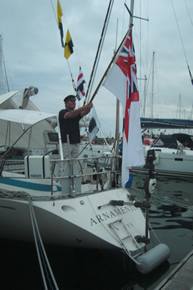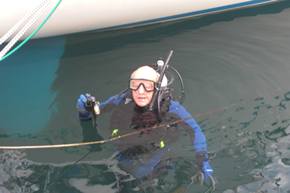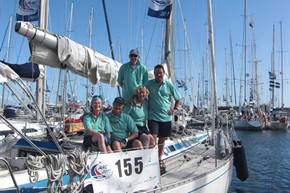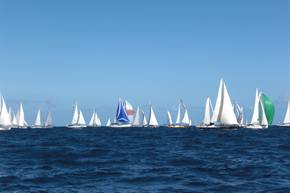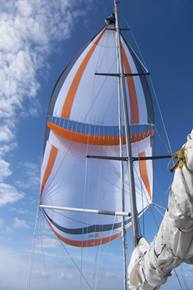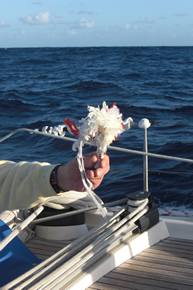24th November - 600NM Down the Track

|
22:48.79N 24:56.10W Thursday 24th November 600 NM out of It’s been a little while since we blogged. There was something of a hiatus in
The harbour dressed overall The inevitable dinghy race in fancy dress
Carol and Penny washing fruit on the pontoon. No stowaway bugs thanks.
From little acorns . . . . She calls a spade a um . . . . The social side of the ARC is pretty full on. The marina at
Sunset on Armistice Day There were one or two admin hoops to be gone through. These included a compulsory safety equipment inspection. In addition we took advantage of the plethora of mainly UK-based expertise on hand to support the ARC to have the rigging checked (“a thing of beauty” is how Jerry the Rigger described Arnamentia’s mast and standing rigging), sort out how to get weather forecasts and maps down over the radio and the satellite communications and confirm what we knew about Percy the Parasailor. More of him anon. Once Chris, Penny and Tim had arrived we switched into high gear to get all the final preparations done, shopping completed and everything stowed in addition to attending a large number of briefings and seminars. Chris did a magnificent job of diving with his sub aqua gear to clean the bottom of the hull, the propeller and the waterline.
What a lovely bottom she’s got! Shortly before departure day we were met in the marina by John and Lyn White from the Ocean Cruising Club. Coincidentally, John had been appointed our OCC mentor earlier this year. This newly instituted initiative aims to link those about to undertake extended cruising with members who have already done so. Since John and Lyn had cruised for 10 years some years ago and, like us were Lymington-based, this proved invaluable and we are very grateful indeed for all they have done to help us. Anyway they were there to host an OCC party on the last evening before departure and asked us to assist – as well as presenting us with a burgee (which we promise not to fly until we’ve completed the required 1000NM unbroken passage – watch this space; it won’t be long now). The morning of Sunday 20th arrived and we fired up the preparation turbo in order to be able to slip our berth shortly after 1100 in good time to recce the start area prior to the start at 1300. As one of the first away from our pontoon we were treated to a rendition of “God Save the Queen” by John and his trumpet. So, no silent sneaking away to tune up whilst pretending that you were taking the ARC non-race (ho, ho) ever so casually!
Just about to slip away to the start line The weather at the start was all one could wish for; sunny with a decent Force 5 blowing from the north to speed us on our way south. The really important things about starting the ARC are not to cross the start line early (you incur a minimum 3 hour penalty) and not to hit or get hit by anyone else. We managed to do all that and got a pretty good start by any standards.
The ARC gets going The next thing that matters is not to get caught out by the acceleration
zone around the eastern side of Gran Canaria. That starts a few miles down the coast
from the start. In that zone the
normal wind is accelerated by 10 or 15 knots more than the stuff you started
in. Ten or fifteen knots on top of
a Force 5 and accompanied by swell is pretty challenging stuff to be flying
spinnakers in – particularly if the result is that you shred it and have another
almost 3,000 NM to sail without it.
So, like most, we chose not to hoist our spinnaker until well clear and
we knew that there were no horrors awaiting us – that wasn’t until about 0300
the next morning (Monday). It
wasn’t ideal hoisting it for the first time (for this crew at least) in the
middle of the night, partly because ours is a slightly unusual beast. He is a Parasailor and his name is
Percy. He should not be confused
with Chris Copeland who is a sailor
Percy smiling for the camera And just to get him into perspective So, what of progress so far? It is now 0900 on Thursday 24th November and we have made a little over 600 NM since we started. Almost all of that has been dead downwind with Percy producing the horsepower. The 24 hours from 1600 Tuesday to 1600 yesterday were particularly productive as we tore downhill in a typical Atlantic 3 metre swell in Force 5 winds with frequent Force 6 squalls lasting for up a quarter of an hour. This is not easy to do and certainly not at night – particularly with practically no moon. It was made doable because Percy is remarkably stable and resistant to the sort of overloading problems that conventional spinnakers suffer from. The result was a very creditable 190 NM run in those 24 hours. It would have been more than that had we not been delayed somewhat by hooking into a pretty decent Mahi Mahi at about 1700 on Tuesday whilst being pulled along by Percy at around 7 knots. Now, I’ve said that Percy is a good guy but he is pretty single-minded. Once he’s got the bit between his teeth it can be difficult to stop him. So, we had to get him down and sit on him in a hurry. And he’s a big boy. And there was plenty of breeze and an unhelpful swell. By the time we’d done that, our Mahi Mahi had remembered some other pressing appointment he had and pushed off. We thought that a bit rude and inconsiderate. But, if we’ve made a little over 600 NM so far that means we have close
to 2,500 NM to go. Plenty of room
for fun and games there. Chafe is a
major issue and it hasn’t taken us very long to realize that. Arnamentia’s guard wires (which help to
stop people falling overboard) are now lagged in old rags and gaffer tape in an
attempt to reduce the chafing of various spinnaker lines on them. Chafe also caused an almost brand new
16mm diameter spinnaker guy (rope) to part yesterday afternoon. The result can be seen in the photo
below. We’re not sure whether to
regard the result as something that we ought to submit to Tate Modern or take it
to market as the absolutely essential yachtsman’s shaving brush. At this rate we might well have enough
to stock a market stall in Well, it Used to be a Rope Amongst a number of other major considerations is the route to
Right, well I think we’ve just about caught up now. This morning we crossed the Tropic of Cancer on our way south – so we’re now formally in the Tropics. We’ll blog anon shortly when we get the chance. Meanwhile all the best to all and please wish us luck. |
